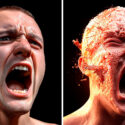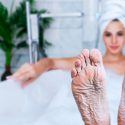You probably already know that tanning under UV lights isn’t good for you. But to see just how harmful tanning beds can be, we’re going to crank up your exposure time from five minutes to 24 hours.
What would happen to your cells? How much vitamin D would you get? What would happen to your organs?
Tanning beds give you that bronzed look by imitating the Sun’s ultraviolet radiation. But tanning under lights isn’t the same as tanning outside. That’s because tanning lamps emit up to six times more radiation than the Sun does.
So spending 20 minutes in a tanning bed is like spending three hours at the beach with no sun protection. And if you spent 24 hours in a tanning bed, well that would be like a torturous 216 hours under a blazing Sun. Would you survive?
You hop onto the tanning bed and close the lid. Up to 50 UV lamps would turn on. But what kind of light would be hitting your skin? The Sun produces several kinds of radiation, including UVA and UVB rays.
Tanning beds usually emit 95% UVA and 5% UVB. But because UVB rays can cause cancer, you’ve chosen to use a new tanning bed that only emits UVA rays. Unfortunately, that wouldn’t save you from the ordeal you were about to experience.
After just a couple of minutes, you’d start seeing a slight tan. The UVA rays would have already penetrated the outermost layer of your skin. As your cells got blasted by radiation, your body would go on the defensive. Specialized cells called melanocytes would produce melanin. This is the brown pigment in your skin that creates skin color.
The melanin would redistribute itself to darken the areas where UV radiation hit your skin. This is a process known as immediate pigment darkening. And its primary purpose isn’t to make you look Sun-kissed.
Your body would start making more melanin to protect your cell nuclei and DNA from the radiation. But if you have fair skin, you have less melanin, so you’d be less protected from the immediate effects of the UVA rays. But even if you have dark skin, you wouldn’t be safe. Radiation would still damage your skin cells.
As you tanned, the blood vessels in the second layer of your skin would begin swelling so they could nourish your burned outer layer of skin. And after several hours in the tanning bed, your body would be struggling to heal itself.
It would increase blood flow to the damaged areas, which would cause swelling, inflammation and pain. Next, you’d get first-degree burns. This is a typical sunburn. Your skin would get red and sore, but it would be able to heal in three to four days under normal circumstances.
After another hour, your skin would start getting painful blisters, and your first-degree burn would turn into a second-degree burn. You’d be in this painful state for hours. And then, the burn would reach the layer of fat beneath your skin. You would now have a third-degree burn.
But surprisingly, it might not feel as painful. Third-degree burns can destroy nerve endings, causing numbness. Your skin would be black, brown or white and take on a leathery texture.
And remember, this burn wouldn’t just cover a single area. Your entire body would experience the irreversible damage of a third-degree burn. Something else would happen too. While your skin was getting burned to a crisp, you’d start getting dehydrated.
The temperature inside a tanning bed is usually about 43 °C (110 °F). So you would be sweating a lot. Your mouth and tongue would get dry. Your eyes would sink in their sockets, and you’d feel extreme thirst and confusion.
Eventually, you’d overheat and get heatstroke. Your heart would race. You’d become agitated and you could have a seizure. As the heatstroke got worse, your brain and other vital organs would swell, causing permanent damage. You could slip into a coma. Or worse, you could die.
If you were able to make it out alive, you would still have serious long-term health issues from all that damage. Your skin would be wrinkled, making you look much older than you are. And your risk of getting melanoma, or skin cancer, would skyrocket.
At least you’d have enough vitamin D to last a lifetime, right? Nope. Tanning beds mostly emit UVA light, but your body needs UVB light to produce vitamin D. The bottom line is, artificial tanning is dangerous. Just one regular length tanning session could increase your risk of getting melanoma by 20%.
Sources
- “UVA Vs. UVB Rays: What’S The Difference?“. 2021. Healthline.
- “Tanning Beds: Safer Than The Sun?”. 2021. Mayo Clinic.
- “The Hard Truth About Tanning | IMPACT Melanoma”. 2021. IMPACT Melanoma.
- “10 Surprising Facts About Indoor Tanning”. 2021. aad.org.
- “The 24 Hour Tanning Law – What You Should Know – Good Looking Tan”. 2018. Good Looking Tan.
- “Everything You Need To Know About Tanning Bed Replacement Lights – Aqua Living Factory Outlets”. 2019. Aqua Living Factory Outlets.



























